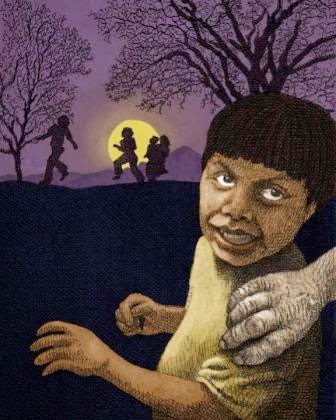BOO! Bilingual Books for Halloween and the Day of the Dead
TRICK OR TREAT?
Let's Do it with Books!
AKA Here Comes La Llorona & her Friends!
Oh, you better be ready for Halloween and the Day of the Dead this year! Here in El Paso, we can already hear La Llorona scratching along the riverbank, practicing her high notes. A friend out hiking saw the tracks of El Cucuy as he galloped across the mountaintops and down thru the arroyos. The big old bogeyman is getting in shape to go looking for bad little girls and boys. And, we know a family lucky enough to live near a cemetery. They swear that late at night they can hear the joyful sound of all the calacas (aka skeletons, aka calaveras) doing their yoga stretches as they get ready for the Day of the Dead. This year it’s going to be special.
Don’t be afraid. Cinco Puntos has your back! If you’re a teacher, a librarian, a parent, a grandparent, or simply an aficionado of Halloween or the Day of the Dead, Cinco Puntos has the books for you.
Written and illustrated by Mexicano Luis San Vicente.
 |
| Copyright illustration © 1999, Luis San Vicente. All rights reserved. Reproduction or copy of this image is not permitted without permission. |
Yes, yes, it’s back by popular demand!
November 1 is Mexico's Day of the Dead, and the skeletons jump for sheer joy. And no wonder: they’ve been cooped up the whole year long doing absolutely nothing. They’re hungry, they’re thirsty, and, my gosh, they’re ready to party. Watch the calaveras shake, rattle and roll as they celebrate the biggest event of the graveyard’s social calendar!
Mexico’s Day of the Dead fascinates kids and adults too, whether for its joyful celebration or its unusual traditions. With fantastic illustrations and a wild and fanciful poem, San Vicente captures the spirit of this most marvelous holiday. And Cinco Puntos added a little flavor to the book. A short and fun essay, directed toward young readers, explains this important Mexican holiday. Plus, we offer directions for making pan dulce (sweet breads), sugar skulls and altars to honor and remember the dead. All the fun things kids can do to join in the festivities!
A great book for Early Readers, a great book for a gift!
And now The Festival of Bones is in paperback. And, like always, the hardback is back too! Indeed, we’d be fools not to reprint the hardback. We already have thirty thousand hardbacks in print!
Conceived and written by folklorist / educator Cynthia Weill
with papier-mâché skeletons by Oaxacan artist Jesus Canseco Zárate
This book is so fun it’s a classic before it’s a classic!
So, you ask, who are those calacas doing their yoga exercises in the cemetery as they get ready for the Day of the Dead? They’re none other than Anita’s familia, her family, who she introduces you to in this new Cynthia Weill collaboration Jesus Canseco Zárate. Cynthia was down in the state of Oaxaca in Mexico, doing what she does best: scouring the mountains, the valleys and the pueblos for folk artists to bring them international attention. Her best-selling First Concepts in Mexican Folk Art series came from this unusual avocation of hers. But, there in Oaxaca City she happened upon the work of Jesus Canseco Zarate. How lucky is that? Here’s how his website explains the calacas he makes:
Jesús Canseco Zárate…has dedicated himself to the art of paper-mâché calacas, or traditional skeleton figures, for the past eight years. His calacas, however, are characterized by a modern twist: they parade around in everyday clothing, wear distinctive hairstyles and are obsessively detailed from head (freckles) to toe (nail polish). Imbued with life, these skeletons walk the threshold between the living and the dead; a cheeky reminder of what awaits us all…Known for his painstaking realism, he specializes in commissions that bring real-life people to… well, death! Indeed, death is represented by Jesús as just another welcomed rite of passage in life.
Looking at his calacacs, Cynthia conceived Mi Familia almost immediately. They started working together. And that's the way true collaborations should work.
By the way, Jesús is a fine photographer too. Visit his photography work here.
The classic bilingual telling by Joe Hayes
Illustrations by Vicki Trego Hill and her daughter Mona Pennypacker
In this part of the world, along the U.S.-Mexico Border, everybody knows the story La Llorona, the Weeping Woman. The Byrd kids Susie, Johnny and Andy, when we moved to El Paso in 1978, learned about La Llorona on the playground in kindergarten and at Crockett Elementary School. Parents or teachers didn't have to tell them the story. The kids did. All the kids knew about La Llorona, knew she lived and knew to scare the new kids with the story. In our neighborhood, la Llorona lives in the Franklin Mountains above our home on Louisville Street. At night she'll come howling out of a canyon, looking for her kids. Oh, wowweeee! Lee and I learned about la Llorona first through our kids and our neighbors, but then we met storyteller Joe Hayes. We became friends. Joe told us a lot about the folklore of the American Southwest and the world (that's something most people don't know about Joe--he's a deeply committed folklorist), and from Joe we learned the history of the legend. But most importantly, we got to publish Joe's telling of the story. Oh, what a great gift that was. We now call Cinco Puntos Press "the House that La Llorona built!” Follow this link to read an interview where Joe talks about this great legend which is certainly an integral part of the culture where we live. And you can go to the CPP website page to hear Joe tell the story first in English and then in Spanish. --Bobby Byrd
As told by Joe Hayes and illustrations by Honorio Robledo
If La Llorona comes around, be careful. You know El Cucuy is somewhere in the neighborhood.
Growing up every one hears at least one teasing reference to the “bogeyman,” but not everyone knows him by name. In the Southwest and much of Mexico, he’s known as el Cucuy (pronounced coo-COO-ee, drawing the COO syllable out like the hoot of a lonely night bird).
With his humped back and his big red ear, el Cucuy was once a standard part of child rearing. Many Mexicans and Mexican-Americans will tell you, “I grew up with el Cucuy.” And there are plenty of stories of lazy, disobedient children whose feet were set back on the straight and narrow path by an encounter with this ogre.
Although today’s parents no longer think it appropriate to rely on calling the local bogeyman to come and carry their children away, the young still delight in tales of bad boys and girls—ones that are much worse than they are!—getting the good scare they deserve from el Cucuy. Of course, the best tales, like this one, always have a happy ending!
So, kids, listen to your parents and grandparents, or el Cucuy might get you!
Joe Hayes
Black and white spot illustrations by Mona Pennypacker
Winner of the 2006-2007 Texas Bluebonnet Award
Do you believe in ghosts?
Well, Elena Padilla’s father didn’t, and that’s a shame, because his disbelief ends up making Elena a very sick girl. In his classic bilingual style, Joe Hayes tells the story of Elena’s ghost fever. The story starts in an old rundown house in a dusty little town in Arizona. Nobody in their right mind will rent that house because…well, a ghost haunts it. The landlord can’t even rent it out for free! That is, not until foolish old Frank Padilla comes along thinking he can save some money.
Lucky for Elena that her grandmother knows all about the mysterious ways of ghosts. With her grandmother’s help and advice, Elena solves the mystery of the ghost girl, recuperates from her ghost fever and, in the process, learns a valuable lesson about life.
Here’s what the late great magazine Criticas, an off-shoot of School Library Journal, had to say about Ghost Fever:
In his first novel-length chapter book, Hayes stays true to his southwestern storytelling roots while also expanding his base. Set in a small Arizona town in the 1950s and told as a childhood memoir, Hayes’s latest story presents a more modern world—with decrepit pickup trucks, family desertion, and the interaction of Hispanic and Anglo residents—than that of his earlier bilingual offerings, which mostly reflected colonial New Mexico. Traditional culture has not disappeared completely, however. While some of the characters in the story scoff at the idea of ghosts and haunted houses, others are convinced of their existence. At the heart of this story lies a haunted house with such a bad reputation that its owner has to lure his new tenants—a father and his 14-year-old daughter—with six months of free rent. While the father ignores the noises and strange occurrences in the house, his daughter cannot—she is not only aware of the ghost in the house, she also knows that it wants her help.
The English and Spanish text flows smoothly and invitingly, and Hayes’s short chapters make this perfect for classroom read-alouds, as well as for independent reading. Sure to be popular with young chapter book readers who enjoy a chill running down the spine, Ghost Fever is also recommended for reluctant older readers. Librarians and booksellers would do well to display and hand-sell this title.
Cinco Puntos Press Books are distributed to the trade





.JPG)

Comments